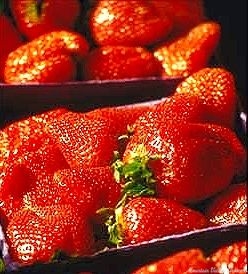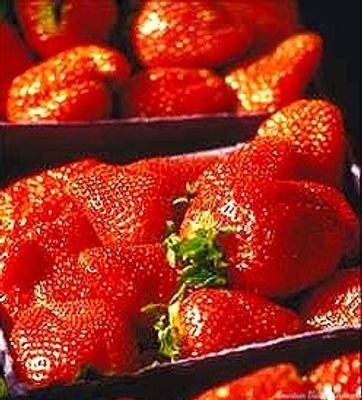Growing & using Albion Strawberry

Nothing says summer like fresh home-grown strawberries. Now potted organic strawberry plants are available shipped directly to your door.
Our potted strawberry plants are already growing and are fully rooted in three-inch pots. They are ready to start producing boxes and boxes of luscious strawberries.
Our day neutral ever-bearing Albion Strawberries produce consistently throughout the production season slowing down only when temperatures are above 90 or 95 (which is quite high for strawberry production) and after frost. Albion has shown resistance to Verticillium wilt (Verticillium dahliae) and Phytophthora crown rot (Phytophthora cactorum) with some resistance to Anthracnose crown rot (Colletotrichum acutatum). The fruit is large with outstanding sweet flavor and firm fruit with attractive internal and external deep red color. This variety that has done well throughout US.
What does an organic strawberry plant mean to you?
It means from the very beginning these plants are grown in fertile, nourishing organic soil and that no chemicals are used in the growing, packing or processing of the plant or the fruit. Commercial strawberry production is extremely dependent on the use of chemical herbicides and pesticides. Most strawberry fields are first treated with a chemical to destroy any pathogens that may interfere with that perfect strawberry and then covered with plastic to keep bugs and weeds at bay. The chemicals can be absorbed by the roots of the plant and taken up by the fruit. This chemical treatment is followed by more spraying to rid the plants of bugs or disease. The use of plastic causes a lot of soil erosion which depletes the soil and makes more chemical fertilizer necessary. And, since strawberries are mostly water, a lot of run off occurs during the watering process taking with it the nitrates and other chemicals found in these fertilizers into common water areas. And, since commercial growers usually start fresh each winter, the onslaught of chemicals and the preponderance of plastic waste is expansive. By growing an organic strawberry in an organic environment, you can truly enjoy one of life’s little pleasures with full assurance that there are no hidden substances in or on your little ruby gems!
A few growing tips for your strawberry success!
Strawberries can be a bit ornery to grow. They have some very specific requirements and there are some helpful things to know about growing them. First and foremost is that they don’t compete with weeds well.
Second in order to grow plump and juicy, they need plenty of water and nutrients plus excellent drainage. Their need for water is compounded by their shallow root system that can dry out easily.
Third, while the strawberry loves the water, the moisture is also very attractive to ground bugs like mealy bugs and earwigs. These little bugs like to hollow out homes for themselves in the berries. The abundance of water can also cause ripening fruit to rot where it touches the ground.
Fourth, Albions that ripen on the plant are the tastiest. Unfortunately, this is also the stage the birds tend to come in and swipe them right out from under you.
It might seem hopeless, but there are some simple solutions. Strawberries seem to grow better in raised beds or in containers. These can be filled with top-quality compost or potting soil which helps to encourage beneficial bacteria and earthworms. Raised beds containing quality topsoil can be filled with strawberries, mulched with compost (which adds to fertility), and covered with clean straw to help conserve moisture and keep the strawberries off the ground. Raised beds need only be a foot tall and two feet wide. Planting two rows of strawberries about 8 inches apart will provide a strawberry bonanza.
Hanging baskets are ideal because the berries can hang in the air, which keeps the ground bugs away. If watering a hanging basket is a concern, any container can be used and placed atop walls or on blocks in the path of automatic sprinklers which keeps water levels more consistent.
If it comes down to you or the birds, you might try a traditional scarecrow or a battery operated motion detector. Motion detector scarecrows will deter a lot of different kinds of critters that might be after your garden goodies. Row covers can also be used to deter birds and flying insects. These light-weight cloths let light, water and air through to the plant and are an inexpensive way to protect your crop.
To encourage nice large plants, runners (also called daughters) can be pruned off during the first part of the growing season. These can be potted up and replanted in another spot. Also, if the plants have not yet reached a good size, the first flowers can be pinched out to encourage more leaf growth, which will mean more food for the strawberries later and more fruit for you. More leaf growth early also provides more shade for the berries during summer.
Pollination by beneficial insects is a must for big plump strawberries. If you have deformed or shriveled fruit it could be because your diversity of insects is lacking. One great way to attract more beneficial insects is to plant a diversity of flowers.
Fertilizing with an organic all purpose during the first phase of growth and an organic bloom fertilizer once the flowers start showing up really helps to keep the plants vigorous and healthy. Healthy plants have fewer disease problems and attract fewer insects.
Strawberries are hardy to Zone 4. Gardens in zones 4 and 5 may benefit from a mulch applied to the strawberries after they go dormant. Straw is typically used and is applied about 2 inches thick over the tops of the plants. This can be removed in the spring if it has not degraded enough for the plants to poke through.
For more information on growing strawberries visit ATTRA.

Strawberry Wine with Herbs
One more delicious way to enjoy homegrown strawberries!.
- 1/2 pound fresh strawberries
- 20 Lemon Balm or Lemon Verbena leaves
- 2 tablespoons Rosemary leaves
-1 bottle of Rose Wine
Wash, hull and slice strawberries. Finely chop herbs. Mix strawberries, herbs and wine in a clean glass container. Close container with a tight fitting lid. Shake mixture well.
Refrigerate for 2 days, shaking it occasionally.
Strain the wine into a pitcher through a sieve lined with a cloth towel. Serve cold.
Recipe courtesy of the PastryWiz. Visit their site for more great strawberry recipes, including tips for making your own chocolate dipped strawberries.

